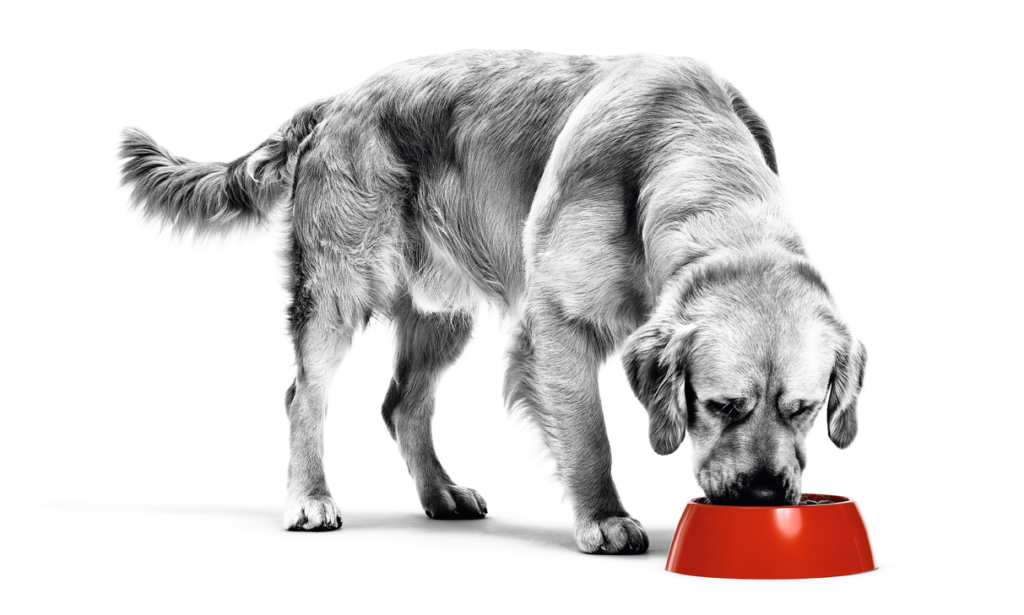To each dog, their own diet
The nutritional requirements of a dog vary greatly from that of man; you shouldn’t be tempted to feed your pets as you feed yourself! Your dog’s daily intake should include not only the energy they require but a balance of all of the nutrients essential to health. The best diets available take these requirements into account specific to the breed, size, age and activity level of your dog. This balanced approach is the basis of Health Nutrition™.
Health Nutrition
Man is an omnivore, with an anatomy and physiology adapted to digest varied foods including meat, vegetables and fruit. The dog has a very specific population of intestinal flora (bacteria) which is much less varied than that of a human (by a factor of 1000!). Amongst other reasons, this explains the dog’s relatively sensitive digestion, and why it’s a mistake to assume that the dog can be fed like Man.
In order to remain fit and healthy throughout their many years, your dog’s diet must satisfy all of their needs, avoiding both deficiencies and excesses. HealthNutrition™ is specifically formulated to meet your dog’s nutritional requirements according to their size, age, activity and physiological condition (whether entire or sterilised). It also takes the sensitivities specific to dog breed into account; the nearly 400 breeds of dog show great variation in the the diet which best serves their needs.
According to size
The Canine species is one of the few in which there is a great range in weight and size. At 1kg, the Chihuahua is a far cry from a 100kg Saint Bernard. This range indicates not only a morphological difference, but a physiological, metabolic and behavioral difference.
One physiological difference, for example, relates to energy requirements. As the dog’s weight increases, their energy requirement per kilogram of body weight decreases. Consequently, a small breed dog should receive a diet with a higher energy concentration than a medium breed dog.
While this theory holds true even in large breed dogs, an increase in food energy-density should be undertaken in order to enable a reduction in meal volume, compensating for a limited digestive capacity. An increase in concentration of energy is mirrored in protein, mineral and vitamin levels.
To promote optimal prehension (consumption of food from the bowl), without wastage and to encourage tooth-cleaning chewing behaviour for example, the kibble should be adapted in shape and texture.
According to activity levels
A working dog (or a hunting dog or rescue dog) will not have the same nutritional requirements as a dog living in a strictly urban environment. Even within a breed differences can be found between working champions and show champions. The dog’s specific activity as it relates to use varies greatly.
Similarly, a bitch expecting puppies has increased requirements for protein, energy and minerals starting as early as the 6th week of gestation. Lactation leads to an even greater demand on intakes due to the exceptional quantities of nutrient-rich milk required to feed a litter of puppies. A 25-kg bitch with 6 pups for example will reach a peak milk production of 2 litres/day 3 weeks after giving birth. Only a specific diet will allow her to meet all of her needs.
According to lifestyle
The risk of excessive gains in weight is a prime example of the impact of lifestyle on requirements. Small-breed dogs with exclusively urban and essentially “Indoor” lifestyles should be identified as high-risk when it comes to weight-gain. These dogs have less of an opportunity to expend energy and, coupled with an owner who rewards (or ‘treats’) their pet by means of feeding in excess of needs, a nutritional imbalance is easily established. A Health Nutrition™ food suited to indoor ‘mini’ breeds provides for the exact requirements when fed according to recommendations. Here we can preserve the dog’s fitness.
According to age
In terms of age grouping, a dog passes from adult to mature and then to senior status throughout their life. Maturity generally starts from the mid-point in life and this is a period when the signs of ageing are not yet visible. At this stage, feeding an adapted formula HealthNutrition™ food can help in the retention of youthful vitality and helps assist the body fight against the effects of cell aging.
At 75-80% of their total life expectancy, dogs are considered ‘senior’. Health Nutrition™ looks to assist dogs with age-related conditions, such that they don’t lead to ill-health. Vitamins E and C, taurine, lutein and beta-carotenes for example support the natural immune defences of the aged dog when included in their diet. Essential fatty acids in fish and borage oils contribute to preservation of skin and coat health also.
Not all aged dogs are the same in their nutritional needs. Be sure to take advantage of the advice and expertise of the staff in your veterinary practice. Regular examinations of all body systems are particularly important in our older pet population and in this way the individual needs of your dog can be identified.